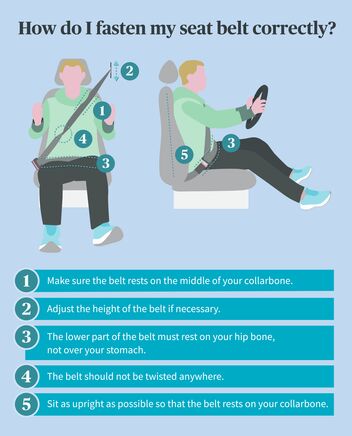
Seatbelts: many adults don’t buckle up properly
Since the three-point seatbelt was introduced, it has saved over a million lives and become the most important piece of safety equipment for any car. However, many adults don’t buckle up properly, and it’s very important that you do, especially if you’re pregnant.
Seatbelts have proven efficient in saving lives in Switzerland too: the Swiss Council for Accident Prevention BFU estimates that they have prevented some 15,000 serious injuries and 1,800 fatal accidents over the past 20 years.
While hardly anyone would ride in the front of a car without a seatbelt, people are less disciplined on the back seat. They tend to underestimate the risk, but it’s essential to buckle up there as well because you can be thrown forward with a force many times your own body weight in an accident, endangering the driver and front passenger.
Why the seatbelt is still number one
Do we really still need to use three-point seatbelts now that we have airbags and various driver aids? The answer is a resounding “yes”. Despite the prevalence of airbags and other safety devices, the seatbelt still offers the best protection in an accident. In newer cars, the seatbelt, pretensioner, force limiter, and airbag are precisely attuned to each other as part of a complete system. The airbag might not deploy at all in a low-speed collision because the seatbelt is sufficient on its own.
Many adults don’t buckle up properly
Most people fasten their seatbelt before setting off, but many just throw it over their shoulder and lap without much thought. It isn’t always easy to fasten it properly in an older car because there isn’t enough adjustment in the anchor point or the seat. Some people don’t buckle up at all because they find seatbelts uncomfortable.
Various studies of how drivers use the three-point seatbelt were carried out to mark 60 years since its invention. One Swedish study made the highly alarming discovery that about half of those who took part weren’t buckling up properly – in the driver’s seat or the passenger seat.
How to fasten your seatbelt correctly

- Contact with the collarbone: Make sure the belt rests on the middle of your collarbone.
- Contact with the hip bone: The lower part of the belt must rest on your hip bone below your stomach, not on the stomach itself.
- No twists: The belt shouldn’t be twisted around your shoulder or lap. This could cause nasty grazing if you have an accident.
- Posture while driving: Drivers should sit as upright as possible so their belt is always in contact with their body. If you recline the back of your seat too far, you risk slipping under the belt in an accident and suffering injuries.
- Body size: You should adjust the belt to suit your size. Pull it out over your shoulder if necessary.
- Accessories: Don’t use a cushion for comfort, it reduces your safety in a collision.
Using seatbelts during pregnancy
Pregnant women have to take a few extra things into consideration when driving, in particular the right way to fasten their seatbelt. The most important thing of all is never to do without a seatbelt for fear of harming the unborn child.
Pregnant women should also make especially sure the belt is positioned correctly. It should be tight enough that it won’t slip upward over the stomach. Special adapters are available to help here. They hold the belt in the right place below the stomach and stop it from slipping.
Some mothers-to-be find a tight seatbelt around their waist uncomfortable, while others are worried that it might harm their unborn baby. The fact, though, is that a seatbelt is the best way to protect both mother and baby on every journey, however long or short.
Are airbags dangerous for pregnant women?
Even expectant mothers should on no account forgo the protection offered by an airbag. That said, it’s important to ensure that the seatbelt is fastened properly. In most cars, it’s also possible to adjust the height of the seat and steering wheel so as to optimize comfort and safety.
Avoid long journeys
In the final trimester of pregnancy, journeys by car – especially longer ones – should be avoided wherever possible. If you absolutely have to drive, you should take a break at least every two hours. It’s a good idea to go for a short walk or do a few stretching exercises because sitting down for long periods is hard on your back, and your legs might swell up. And don’t forget to drink plenty of water.





